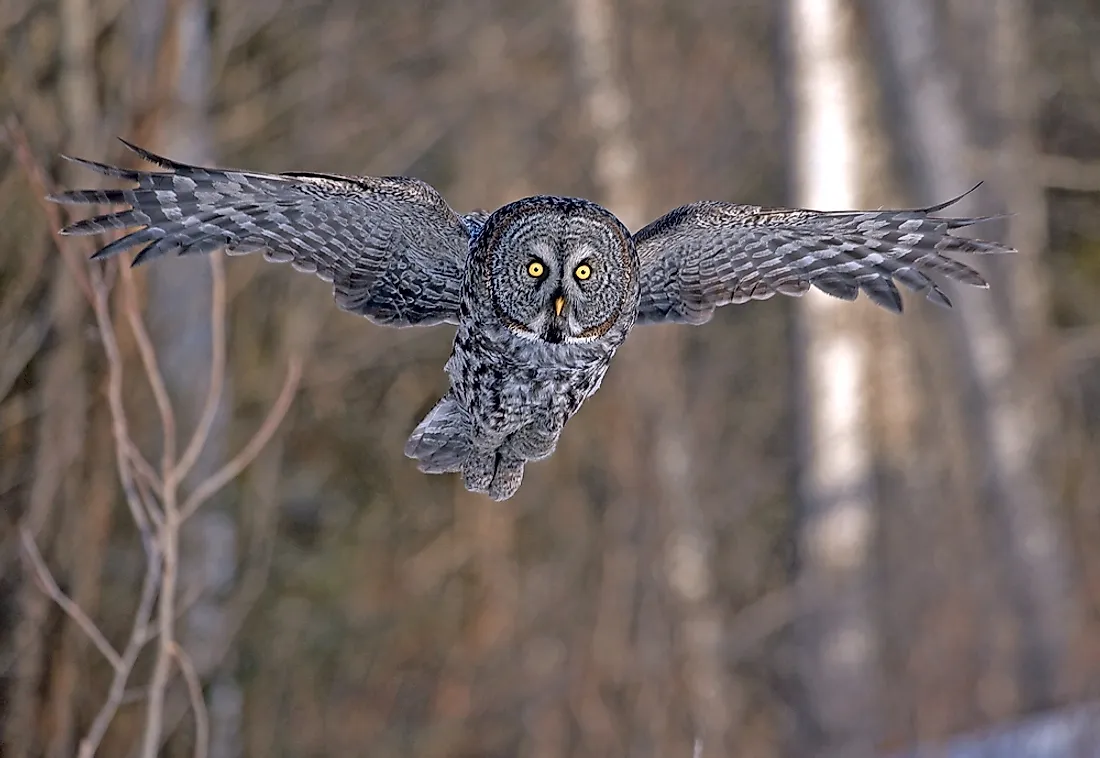What is the World's Largest Owl Species?

The world’s largest owl is called the great grey owl, scientifically known as Strix nebulosa. “Nebulosa” is a Latin word meaning “misty or foggy.” It is popular for being the provincial bird of the Canadian province of Manitoba. Other names used to refer to this unique bird include the bearded owl, cinereous owl, and Phantom of the North. The great grey owls inhabit areas such as Alaska, northern Minnesota, northern Rocky Mountains, northern Europe, and Asia.
Physical Description
Adult great grey owls have large, round, and silvery grey faces. The bird’s large head has no ear tufts. They also have yellow, relatively small eyes as well as the largest facial disc ever possessed by a raptor. The grey owls have feathered feet and legs coupled with long sharp talons. The average weight is 1.28 to 4.19 lbs and the average length is 61-84 centimeters with wingspans averaging 5 ft. Like most owl species, the males are smaller than the females.
Behavior
The great grey owls are less aggressive compared to most birds. They neither defend their nesting territories nor attack each other. However, the female owls are aggressive in protecting their eggs and owlets. They are most aggressive when the fledglings prepare to take their first flight. Since they are generally less aggressive, it is difficult to trace the great grey owl. They do not even respond to calls made by their own species. In the presence of humans, the great grey owls often go unnoticed. The great grey owls are most active in the night, at dawn and at dusk. They have a distinct primary call that is soft and low-pitched.
Regarding breeding, the great grey owls rarely build their nests. Instead, they use nests built by other large birds of prey. The eggs laid by the females undergo an incubation period of 28-36 days. As soon as they hatch, the female owl jealousy guards it against predators and any other threats. They protect the owlets until they begin to fly and then hand them over to the male owls. Males are responsible for ensuring that the young ones feed well and learn to fend for themselves such as learning to hunt for their own food.
Feeding Habits
The great grey owls mainly hunt for food during the night, at dusk, and at dawn since they are very active during these times. The birds mainly feed on snakes, rodents, moles, chipmunks, mice, crows, rabbits, and squirrels among others. Whatever they feed on depends on several factors such as the abundance and availability of the prey. To catch their prey, the great grey owls sit quietly, listen and watch for their prey.
Threats
The greatest threat to the existence of the great grey owl is the harvest of timber resulting in loss of habitat. Consequently, the owls lack a place to roost, nest, and dense tree covers for protection. The other dangers that affect the great grey owl include rodenticides, the West Nile Virus, and collisions with vehicles. Normally, the great grey owls live for approximately 40 years. However, many of them do not live their full lives due to the many threats posed by the above-mentioned factors.











